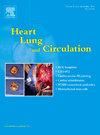Coronary Inflammation in Patients With and Without Standard Modifiable Cardiovascular Risk Factors: Insights From a Novel Computed Tomography Imaging Biomarker Pericoronary Adipose Tissue Attenuation
IF 2.2
4区 医学
Q2 CARDIAC & CARDIOVASCULAR SYSTEMS
引用次数: 0
Abstract
Background
Significant progress has been made in coronary artery disease (CAD) prevention by targeting standard modifiable cardiovascular risk factors (SMuRFs), which include hypertension, hyperlipidaemia, diabetes mellitus, and smoking. However, there is growing incidence of CAD occurring in the absence of SMuRFs, a phenomenon now termed “SMuRF-less” CAD. Identifying novel biomarkers and mechanisms for SMuRF-less CAD is crucial for new therapeutic strategies in this under-recognised group. The role of inflammation in CAD has been extensively studied and was recently validated as a therapeutic target.
Aims
This study aimed to assess coronary inflammation in patients without SMuRFs and patients with SMuRFs using pericoronary adipose tissue (PCAT) attenuation, a novel and specific biomarker of coronary inflammation quantified on computed tomography coronary angiography (CTCA). Our secondary aim was to compare the coronary plaque burden and coronary artery stenosis severity between the groups.
Method
We conducted a retrospective single-centre study of 309 consecutive patients who underwent clinically indicated serial CTCAs for suspected stable CAD (2010–2016) at Monash Health, Melbourne, Australia. Patients with a history of CAD were excluded. PCATRCA attenuation measurement around the proximal right coronary artery (RCA) was performed using semiautomated software. Plaque burden was assessed using the segment involvement score (SIS) and segment stenosis score (SSS). Coronary artery diameter stenosis severity was assessed using the Coronary Artery Disease - Reporting and Data System (CAD-RADS) classification.
Results
In the final study population of 309 patients (median age 57.5 years; 51.8% female), 83 (26.9%) patients were SMuRF-less. Baseline characteristics were similar between patients without SMuRFs and those with SMuRFs, and patients with SMuRFs were more frequently on statins, angiotensin-converting enzyme inhibitor/angiotensin receptor blocker, and aspirin. Patients without SMuRFs had a similar PCATRCA mean attenuation (Hounsfield units, HU) compared with patients with SMuRFs (−77.5±9.5 vs −78.4±8.9 HU; p=0.481), despite having a lower coronary plaque burden and stenosis severity. The mean SIS and SSS were 18.7% and 39.5% lower, respectively, in patients without SMuRFs than in those with SMuRFs (SIS: 1.78±2.19 vs 2.72±2.88, p=0.01; SSS: 2.22±3.36 vs 3.67±4.38; p=0.004). Patients with SMuRFs were more likely to have obstructive CAD than patients without SMuRFs (odds ratio 2.8; 95% confidence interval 1.3–5.7; p=0.006).
Conclusions
In patients undergoing clinically indicated CTCA, patients without SMuRFs exhibited a similar degree of coronary inflammation to those with SMuRFs, despite having a lower plaque burden and stenosis severity. These findings may provide early mechanistic insights into why patients without SMuRFs still develop CAD and subsequent cardiovascular events. Further research is needed to validate these findings. If confirmed, the therapeutic target of inflammation could be explored further in patients without SMuRFs.
有或没有标准可改变心血管危险因素的患者的冠状动脉炎症:一种新的计算机断层成像生物标志物冠状动脉周围脂肪组织衰减的见解
背景:针对标准可改变的心血管危险因素(smurf),包括高血压、高脂血症、糖尿病和吸烟,在预防冠状动脉疾病(CAD)方面取得了重大进展。然而,在没有smurf的情况下,CAD的发病率越来越高,这种现象现在被称为“SMuRF-less”CAD。在这一未被充分认识的群体中,确定新的生物标志物和机制对于新的治疗策略至关重要。炎症在CAD中的作用已被广泛研究,最近被证实是一种治疗靶点。目的:本研究旨在通过冠状动脉周围脂肪组织(PCAT)衰减来评估无SMuRFs患者和SMuRFs患者的冠状动脉炎症,PCAT衰减是一种新的特异性冠状动脉炎症生物标志物,可在计算机断层冠状动脉造影(CTCA)上量化。我们的次要目的是比较两组之间冠状动脉斑块负荷和冠状动脉狭窄严重程度。方法:我们在澳大利亚墨尔本Monash Health进行了一项回顾性单中心研究,对309例连续接受临床适应症连续ctca治疗的疑似稳定型CAD患者(2010-2016)进行了研究。排除有CAD病史的患者。采用半自动软件测量右冠状动脉近端(RCA)周围的PCATRCA衰减。采用节段受累评分(SIS)和节段狭窄评分(SSS)评估斑块负担。使用冠状动脉疾病报告和数据系统(CAD-RADS)分类评估冠状动脉直径狭窄的严重程度。结果:在最终的研究人群中,309例患者(中位年龄57.5岁,女性51.8%),83例(26.9%)患者smurf较少。无smurf患者和有smurf患者的基线特征相似,有smurf的患者更频繁地服用他汀类药物、血管紧张素转换酶抑制剂/血管紧张素受体阻滞剂和阿司匹林。没有smurf的患者与有smurf的患者相比,PCATRCA平均衰减(Hounsfield单位,HU)相似(-77.5±9.5 vs -78.4±8.9 HU; p=0.481),尽管冠状动脉斑块负担和狭窄严重程度较低。无SMuRFs患者的平均SIS和SSS分别比有SMuRFs患者低18.7%和39.5% (SIS: 1.78±2.19 vs 2.72±2.88,p=0.01; SSS: 2.22±3.36 vs 3.67±4.38,p=0.004)。有SMuRFs的患者比没有SMuRFs的患者更容易发生阻塞性CAD(优势比为2.8;95%可信区间为1.3-5.7;p=0.006)。结论:在接受临床适应症CTCA的患者中,没有SMuRFs的患者表现出与SMuRFs患者相似的冠状动脉炎症程度,尽管斑块负担和狭窄严重程度较低。这些发现可能为为什么没有smurf的患者仍然会发生CAD和随后的心血管事件提供早期的机制见解。需要进一步的研究来验证这些发现。如果得到证实,则可以在没有smurf的患者中进一步探索炎症的治疗靶点。
本文章由计算机程序翻译,如有差异,请以英文原文为准。
求助全文
约1分钟内获得全文
求助全文
来源期刊

Heart, Lung and Circulation
CARDIAC & CARDIOVASCULAR SYSTEMS-
CiteScore
4.50
自引率
3.80%
发文量
912
审稿时长
11.9 weeks
期刊介绍:
Heart, Lung and Circulation publishes articles integrating clinical and research activities in the fields of basic cardiovascular science, clinical cardiology and cardiac surgery, with a focus on emerging issues in cardiovascular disease. The journal promotes multidisciplinary dialogue between cardiologists, cardiothoracic surgeons, cardio-pulmonary physicians and cardiovascular scientists.
 求助内容:
求助内容: 应助结果提醒方式:
应助结果提醒方式:


